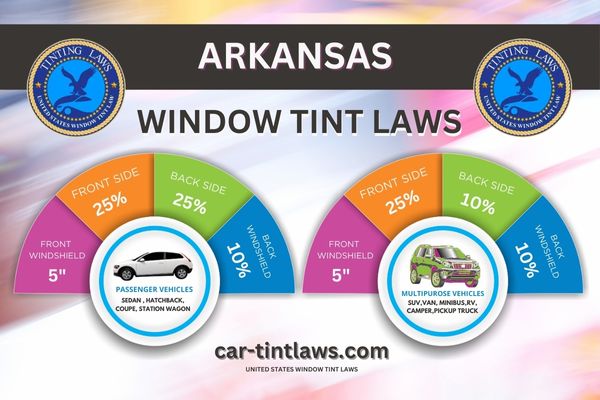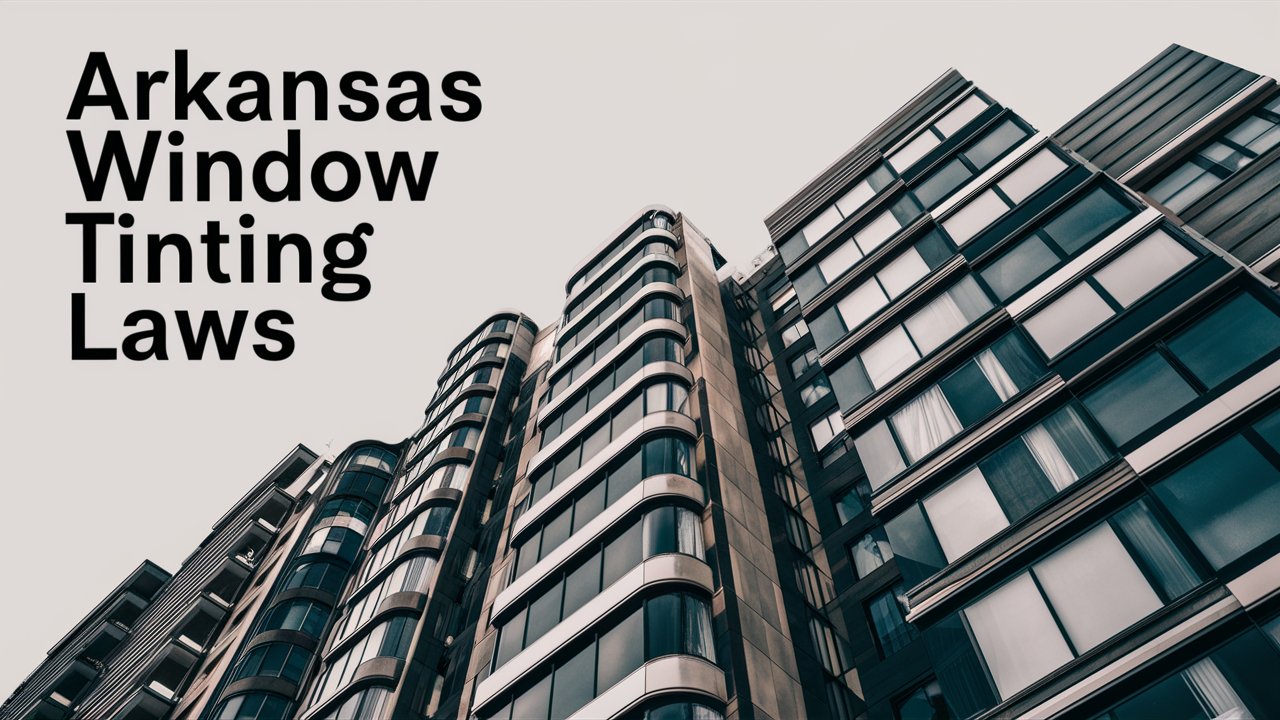When it comes to window tinting in Arkansas, balancing personal preferences with legal requirements can be a tricky endeavor.
You might enjoy the sleek look and added privacy that darker tints provide, but state laws impose specific restrictions you can’t ignore.
For instance, front side windows on sedans must allow more than 25% of light in, while rear windshields can be darker.
Reflective tints are a no-go, and compliance stickers are mandatory for aftermarket installations.
Ever wonder how these laws impact your daily drive and safety? Let’s explore further.
Window Tint Darkness in Arkansas
When it comes to tint darkness for sedans in Arkansas, the front side windows must allow more than 25% of light in, while the rear windshield can be as dark as 10% VLT.
For SUVs and vans, the same rules apply to the front side windows, but the rear windows and rear windshield can be more heavily tinted.
These guidelines guarantee that drivers have sufficient visibility, while also permitting some variation for different vehicle types.
Tint darkness for sedans:
In Arkansas, the tint darkness regulations for sedans are as follows:
- Windshield: Non-reflective tint is permitted on the top 5 inches.
- Front Side windows: Must have a Visible Light Transmission (VLT) of at least 25%.
- Back Side windows: Must have a VLT of at least 25%.
- Rear Window: Can have a VLT as low as 10%.
It is important to note that the use of metallic window tint is prohibited on sedans in Arkansas.
By complying with these tint darkness guidelines, you ensure both the safety and legality of your vehicle while enjoying the benefits of window tinting.
Tint darkness for SUV and Vans:
- Windshield: Non-reflective tint is allowed on the top 6 inches of the windshield.
- Front Side windows: The VLT must be at least 25%.
- Back Side windows: Must have a VLT of at least 25%.
- Rear window: Must have a VLT of at least 25%.
Moreover, metallic or reflective window tint is prohibited on SUVs and vans in Arkansas to prevent glare and visibility issues for other drivers.
All aftermarket tint installations must include compliance stickers to demonstrate adherence to the state’s legal requirements.
Window Tint Reflection in Arkansas
In Arkansas, you’re not allowed to use reflective or metallic window tint on sedans, SUVs, or vans, as this rule helps uphold road safety and visibility.
The regulations aim to guarantee that all vehicles comply, preventing any excessive glare that could impair the vision of other drivers.
Non-reflective tint is permitted on the top five inches of the windshield for all vehicle types, providing a balance between sunlight control and visibility.
Tint reflection for sedans:
- Front Side windows: Sedans in Arkansas are prohibited from having reflective or metallic window tint.
- Back Side windows: Sedans must adhere to non-reflective tint regulations to ensure compliance with Arkansas law.
- Windshield: Sedans can have non-reflective tint on the top five inches of the windshield.
- Penalties for non-compliance: Exceeding the allowable reflection level on sedan tint can result in fines and the requirement to remove or replace the tint.
- Safety and Compliance: Non-reflective tints that meet Arkansas standards are safer and align with legal requirements.
- Choosing the right tint: Select window tint for your sedan that complies with Arkansas guidelines to avoid penalties and promote safer driving conditions.
- Community Responsibility: Understanding and following these tint regulations for sedans reflects responsible citizenship and contributes to overall road safety.
Tint reflection for SUV and vans:
- Front Side windows: Reflective tint is strictly prohibited.
- Back Side windows: Reflective tint is strictly prohibited.
Other Arkansas window tint rules and regulations
- Side Mirrors: No restrictions.
- Restricted Colors: In Arkansas all tint colors are permitted.
- Certificates: Manufacturers of film need to certify the film they sell in the state. Ask your dealer if they are using certified film.
- Stickers: The sticker/label of compliance to identify legal tinting is required between the film & glass on each tinted window.
- Medical Exceptions: Arkansas permits medical exemptions for special tint. For more details about the specific terms of the exemption, consult AR state law.
- Penalties: Maximum $100 and/or 10 days in prison for first conviction. Second conviction within a year max $200 and/or 30 days in jail. Third and subsequent offense within a year $500 and/or up to 3 months in prison.

Medical Exemptions for Window Tint Rules in Arkansas
If you have a qualifying health condition, you can obtain a medical exemption for darker window tints in Arkansas with certification from a licensed physician.
This exemption allows you to use tints that are darker than the standard limits set by Arkansas window tint laws.
To qualify, you’ll need a physician’s certification that confirms the medical necessity for these darker tints due to specific health conditions.
Medical exemptions in Arkansas are valid for three years from the date of issuance.
During this period, you must comply with the specified tint percentages allowed for windshields, side windows, and rear windows as stated in your exemption.
It’s essential to carry the certification in your vehicle at all times to avoid any potential legal issues.
Arkansas Window Tint Ticket Cost
Getting caught with illegal window tints in Arkansas can lead to fines ranging from $100 to $500.
The ticket cost varies depending on the severity of the violation and whether it’s a repeat offense.
Arkansas law mandates a minimum Visible Light Transmission (VLT) percentage of 25% for front side windows and 10% for rear windows.
Additionally, non-reflective tint is only allowed on the top five inches of the windshield.
It’s important to comply with these tinting regulations to avoid the inconvenience of fines and potential jail time.
Adherence to Arkansas window tint laws is not just about avoiding fines; it’s also a matter of road safety.
Non-compliant tints can impair visibility, increasing the risk of accidents.
If you’re ticketed, you may also be required to remove the non-compliant tint to bring your vehicle up to code.
By following the VLT percentage guidelines and using only permitted non-reflective tint, you can guarantee that your vehicle meets Arkansas’s standards.
Staying informed about these regulations helps you steer clear of legal trouble and contributes to safer driving conditions for everyone on the road.
Arkansas Climate and Geography
Arkansas’ humid subtropical climate, with its hot summers and mild winters, makes window tinting essential for protecting against intense sunlight.
With an average of 213 sunny days each year, the intensity of sunlight varies across the state’s diverse geography, from mountains to rivers.
Understanding these seasonal temperature variations, sunlight intensity levels, and regional weather patterns can help you choose the right window tinting for your vehicle.
Seasonal Temperature Variations
Understanding Arkansas’ seasonal temperature variations is necessary for selecting the right window tinting to combat the state’s hot, humid summers and mild winters.
With average summer temperatures ranging from 80-95°F, and high humidity levels making it feel even hotter, choosing window tinting that effectively reduces heat and glare is important.
By doing so, you can guarantee a more comfortable indoor environment during the sweltering summer months.
In contrast, Arkansas’ winters are relatively mild, with temperatures typically dropping to 30-50°F.
While the need for heat reduction is less vital in winter, window tinting can still provide benefits by reducing heat loss and maintaining a consistent indoor temperature.
This helps in lowering energy consumption and improving overall comfort.
The state’s diverse geography, including the Ozark and Ouachita Mountains, can influence local climate patterns.
These variations mean that understanding the specific conditions in your area is crucial when selecting the appropriate window tinting.
Arkansas window tinting laws also need to be considered to ensure compliance with legal standards.
Adhering to these laws while addressing the state’s seasonal temperature variations will help you achieve the best balance between comfort, energy efficiency, and legal requirements.
Sunlight Intensity Levels
Due to its southern location, Arkansas experiences high sunlight intensity levels, making UV protection a key consideration for window tinting.
The state’s geographic location means hot summers with abundant sunshine, leading to increased UV exposure, which can penetrate car windows.
This makes proper window tinting essential for reducing sun exposure and protecting vehicle occupants.
In Arkansas, understanding sunlight intensity levels is important when choosing window tint options.
You need to make sure that your tinting provides adequate protection against the damaging effects of UV rays.
Compliance with Arkansas window tinting laws not only helps in mitigating sunlight intensity levels but also ensures the safety and comfort of everyone inside the vehicle.
For those with medical conditions that heighten sensitivity to sunlight, enhanced window tinting can offer much-needed relief.
Medical exemptions may be available, allowing for darker tints to provide better UV protection.
Always verify that your chosen window tint complies with Arkansas regulations to avoid penalties and ensure best safety.
Regional Weather Patterns
The humid subtropical climate in Arkansas means you’ll experience hot, sticky summers and relatively mild winters.
This diverse state features mountainous regions in the northwestern part and flat plains in the southeastern area, creating varied regional weather patterns.
With an average of 50 inches of rainfall annually, Arkansas sees frequent thunderstorms, particularly in the spring and summer months.
These storms can bring severe weather, including tornadoes, which are common during the spring and fall.
Winter in Arkansas is generally mild, with relatively low winter snowfall.
However, you might encounter occasional freezing rain events during colder months.
The mountainous regions can sometimes receive more precipitation than the flat plains, leading to localized differences in weather patterns.
Understanding these regional weather patterns is essential for residents, especially when considering window tinting laws.
The varied geography and climate mean you need to be prepared for different conditions, from severe storms to hot and humid summers.
By staying informed about Arkansas’s climate and geography, you can make better decisions about protecting yourself and your vehicle from the elements, ensuring you stay comfortable and safe throughout the year.
References
Arkansas Section 27-37-306: Light transmission levels for the tinting of motor vehicle windows
Frequently Asked Questions
What Is the Darkest Legal Tint in Arkansas?
You’re wondering about the darkest legal tint in Arkansas, right? Front side windows can have 25% tint percentages, providing UV protection, heat reduction, and privacy.
Rear windshields allow 10%, enhancing vehicle appearance, while ensuring safety regulations.
Can You Get Pulled Over for Tint in Arkansas?
Yes, you can get pulled over for tint violations. Tint enforcement in Arkansas includes checking tint percentages and visibility.
Non-compliant tints can lead to fines, penalties, and mandatory inspections. Be aware of tint regulations and exemptions for safety.
What Is the Tint Exemption in Arkansas?
The tint exemption in Arkansas allows you to modify your vehicle for medical reasons, ensuring UV protection and heat reduction.
Safety regulations mean commercial vehicles and others need certification. It’s about privacy, car customization, and interior temperature control.
What Is the Legal Tint in Arkansas 2024?
In 2024, you’ll need a tint percentage of 25% or higher for front windows and 10% for rear.
Tint regulations are strict, with tint enforcement ensuring compliance. Tint violations could lead to fines, so prioritize tint safety.
Conclusion
To sum up, understanding Arkansas window tinting laws is vital for ensuring compliance and safety.
Front side windows must allow more than 25% of light, rear windshields for sedans can be as dark as 10% VLT, and reflective tints are prohibited.
Compliance stickers are required, and medical exemptions are possible with proper certification.
By adhering to these regulations, you’ll be driving within the bounds of the law, keeping both yourself and others safe on the road.
